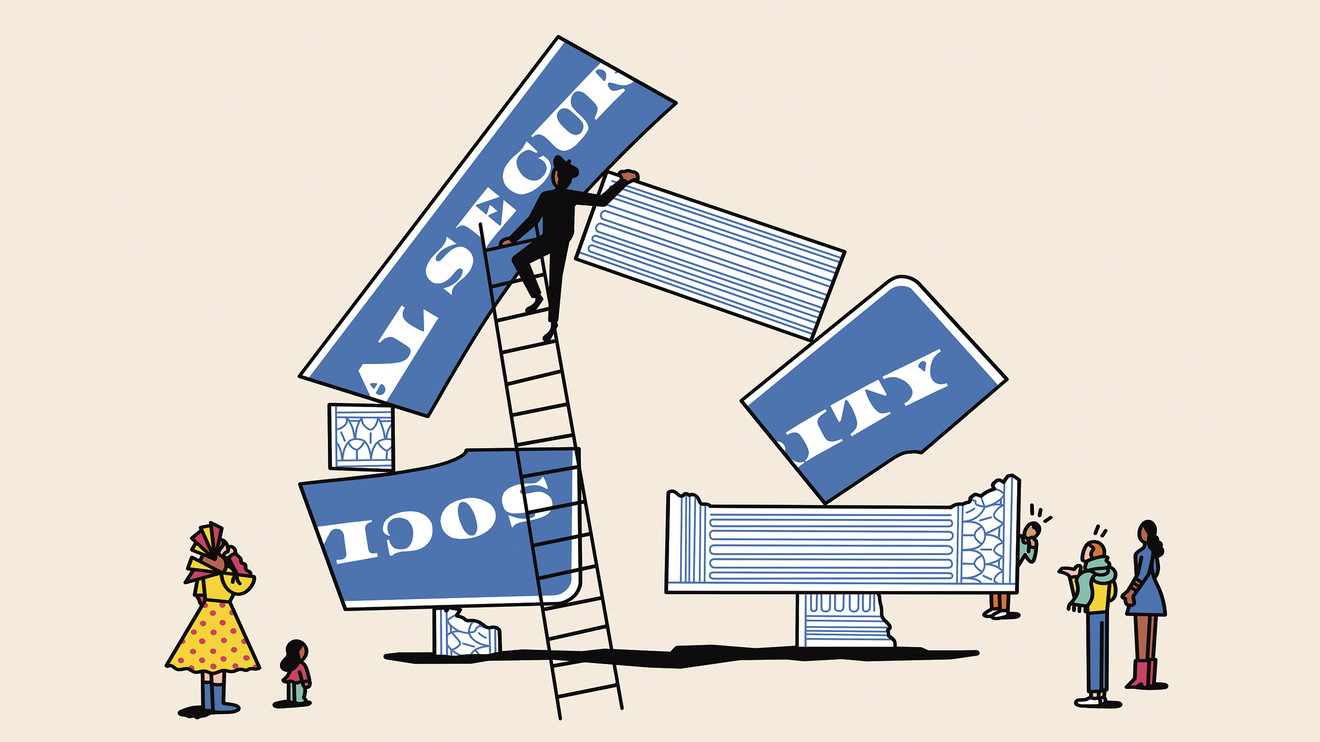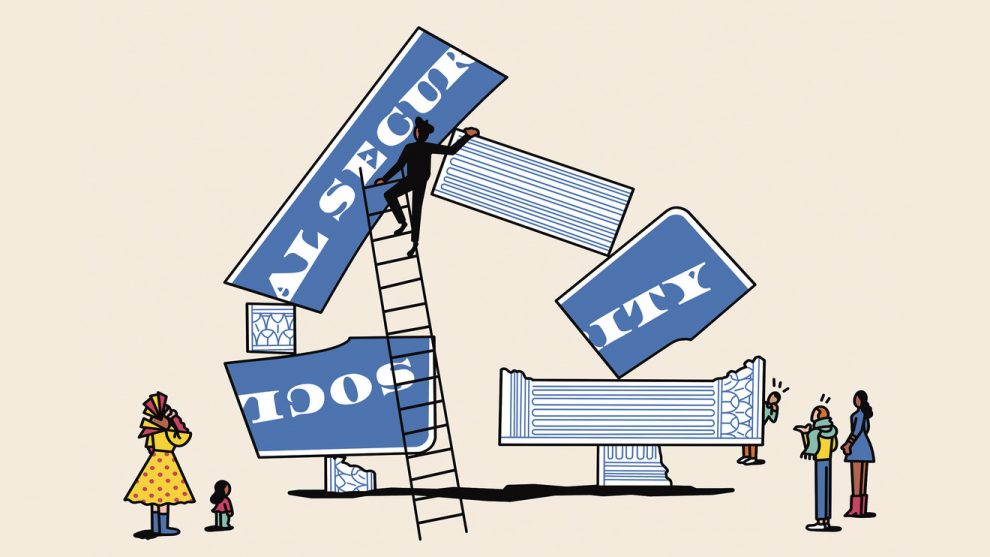
Imagine if Social Security were a hybrid system, with one part funded through payroll taxes and another operating similarly to a 401(k) plan.
Along with the monthly benefit check that Americans already receive in retirement, retirees would have an additional pool of money to withdraw from, accumulated through years of contributions.
Under this system, the fundamentals of Social Security wouldn’t change much. Employees and employers would still split responsibility for the payroll deduction, and retirees would get a check starting as early as age 62. But, under the proposed second branch of Social Security, Americans would be able to save on their own in a supplemental retirement account, regardless of whether they have access to an employer-sponsored 401(k) or similar account. The money would be contributed through payroll deductions, just as the payroll tax is taken out of a paycheck to fund the system now, and placed in an account similar to the tax-deferred Thrift Savings Plan that the government uses for federal employees.
Most Americans are underfunded for retirement partly because some lack access to a 401(k) or other employer-sponsored plan. In fact, some of the baby boomers closest to retirement have only $157,000 saved in their 401(k), and the generation behind them, $71,000, according to a TransAmerica Center for Retirement Studies report. The proposed hybrid system would be a first step to ensuring financial security in retirement, as it would make it simple for working Americans to set aside money for the future at levels they’ve determined, said Chad Parks, an advocate of such a plan. He’s the founder and chief executive officer of Ubiquity Retirement + Savings, a company that provides retirement plans to small businesses. Paying into Social Security is already mandatory for most workers, and it isn’t attached to any company, he noted. Employees and employers share the 12.4% tax (unless the worker is self-employed, in which case he or she pays all of it). The second prong of the hybrid Social Security account would be funded with contributions in excess of that 12.4%. “Maybe even up to 20%,” Parks said.
Proposals have been written around ideas like this. Marc Goldwein, senior vice president and senior policy director for the Committee for a Responsible Federal Budget, a bipartisan nonprofit that educates the public on issues with fiscal-policy impact, and his colleagues drafted a proposal for Social Security reform recently that included incorporating an automatic supplemental retirement account, saying that doing so would ensure Americans have a nest egg to fall back on when they retire, in addition to a Social Security check.
Their proposal suggests workers automatically begin funding the supplemental account with 2% to 3% of their wages, but with a choice available to opt out of the program. Studies have shown that workers are more likely to stay in a plan if they’re automatically enrolled, especially if an employer match is included. (Companies would not be required to add or match contributions to these plans under this proposal.)
Read: How to find the best place to retire
How we got here
The trust funds that fuel Social Security are expected to run out of money by 2035, and if that occurs, the program will rely on revenue from current taxes to pay out benefits. Should nothing change before then, future retirees would still get a benefit check, but for only 80% of what they’re owed, according to the Social Security Administration’s recent trustee’s report.
“Unless we take action, which Congress has the ability to do, millions of retirees will be in a precarious situation when they retire,” said Alan Barber, policy director at the Congressional Progressive Caucus Center, a left-leaning political-action committee.
Americans are already in the midst of a retirement crisis. The average 401(k) account balance for all investors was about $104,000 in 2017, and the median was just over $26,000, according to Alicia Munnell, director of the Center for Retirement Research at Boston College. There are a small number of accounts with large balances (typically those of affluent participants), which causes such a large discrepancy between the mean and median. For comparative purposes, the average account balance for participants between 55 and 64 — those closest to retirement — was $191,000 in 2017, while the median was $71,000.
And that’s if workers are even offered a 401(k), which most are not. Only 14% of companies had 401(k) plans for their employees in 2012, according to a 2017 report by two U.S. Census Bureau researchers who reviewed W-2 tax forms. The companies that did were mostly larger, and only a third of workers with access to a 401(k) were actually contributing. States have stepped in to offer, and in some places mandate, retirement plans, in the form of individual retirement accounts that automatically enroll employees. One caveat, however, is that these and all IRAs have significantly lower contribution limits. An individual can save $19,000 a year in a 401(k) plan, plus an additional $6,000 if they’re over 50, compared with only $6,000 for an IRA, plus $1,000 in catch-up contributions for people 50 and older. And, unlike many 401(k) plans, these programs do not allow a company match.
Only 14% of companies had 401(k) plans for their employees in 2012. The companies that did were mostly larger, and only a third of workers with access were actually contributing to the plans.
The uneven success rate of personal savings is why Social Security serves as a lifeline for many older Americans and their families. One-third of retirees receive nearly all of their income from their benefit checks, according to the Social Security Administration. The average monthly Social Security benefit check was about $1,400 in January 2019, according to the SSA.
Experts are hopeful the program will avoid insolvency in the next decade and a half. “Social Security never reached a point where it couldn’t pay full benefits because Congress always eventually steps in,” said Steve Goss, chief actuary at the Social Security Administration. Although many Americans question whether they will get a benefit check in the future, they shouldn’t, said Nancy Altman, president of Social Security Works, an organization dedicated to maintaining Social Security and partially funded by the public. “It’s called Social Security for a reason; it’s supposed to give you security, a peace of mind,” she said.
Others aren’t as optimistic. “The most likely path is we fail,” Goldwein said. “We get to 2034 and throw our hands up and say, ‘It’s too hard.’”
A 401(k)-style Social Security
There’s no set way the funds in a supplementary Social Security account would be invested. One strategy would center on well-diversified, low-fee funds owned by the worker. Another could feature a portfolio of stocks and bonds or a target-date fund, which places younger workers in higher-risk investments and gradually shifts to lower-risk options as they get older. Proposals like Goldwein’s and Parks’s incorporate choosing from a list of diversified funds across stocks and bonds. Were such a plan to move toward implementation, legislators would need to address numerous other considerations, such as whether the government would provide matching contributions as an extra incentive to save or how and when workers would withdraw assets, said Melissa Favreault, a senior fellow at the Urban Institute, a Washington, D.C.-based think tank.
This is not the first time an add-on has been proposed for Social Security, but the notion has a better chance to stick as Americans grow increasingly anxious about a potentially insolvent system. Lawmakers, by and large, haven’t wanted to touch Social Security legislation. “Even if there’s considerable agreement to automate savings, there’s wide disagreement over what that should look like,” Goldwein said, with constituencies ranging from unions to employers to financial-services firms.
This idea falls in the midst of numerous other suggestions to fix Social Security, such as changing the way benefits are calculated and increasing the full retirement age at which one would get 100% of the benefit owed (the full retirement age currently stands at 67 for people born in or after 1960). It’s different from George W. Bush’s proposal to privatize Social Security in 2005, which would have invested workers’ contributions in equities (thus potentially increasing their rate of return — but also their exposure to risk) instead of the Treasury bonds that the program uses. Many Americans at the time said Social Security had major problems, but Americans were torn over whether privatizing the program was the right move: 40% said it was a good idea, and 55% said it was a bad one, according to a January 2005 Gallup poll for CNN and USA Today.
A hybrid approach would mean workers would have retirement savings they know they can fall back on, if they chose to participate. “I think this would put me out of business but in a way, that’s OK as long as we accomplish financial security for everyone,” said Parks, of Ubiquity Retirement + Savings. Of course, in a new hybridized system, companies could still offer retirement accounts to employees, and investment firms would still have IRAs and other plans for those who want to save even more.
Still, a supplemental account wouldn’t prevent Social Security from running out of money, and the program itself still needs immediate attention and infrastructure changes made possible through law. “It can serve as a sweetener for insolvency issues, but it doesn’t get you out of them,” Goldwein said.
Why it all matters
Americans in or near retirement are safe for now, but the country as a whole is facing an impending retirement crisis.
Decades ago, retirement income was based on three sources: a worker’s pension, his or her own savings and Social Security. But most private companies have moved away from traditional pension plans. Some financial advisers tell younger clients with doubts about receiving Social Security not to consider it in their calculations at all. That way, no matter how small or large the Social Security check they ultimately receive, they’ll be prepared.
“I would rather tell investors to take ownership themselves,” said Bill Van Sant, senior vice president and managing director at Girard Investment Services in Souderton, Pa., effectively endorsing a central concept of supplemental retirement accounts. “Rely 100% on what you can control.”
Read more of the Best New Ideas in Retirement
• This is how much you need to save for retirement
• Long-term care insurance is a dying industry. Here are new ways the high costs of aging
• How robots and your smart fridge can help keep you out of a nursing home
• You’re probably not ready to retire — psychologically
• Retirement is an emotionally and financially charged life stage — ignore it at your peril









